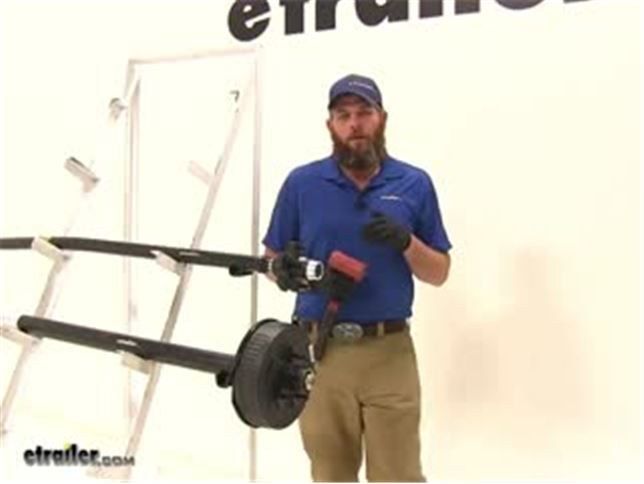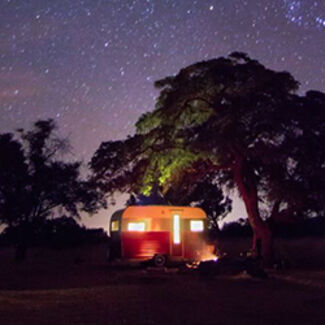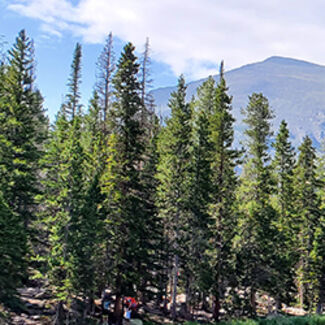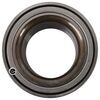
50MM Nev-R-Lube Bearing for 8,000-lb Dexters - Qty 1

Thank you! Your comment has been submitted successfully. You should be able to view your question/comment here within a few days.
Error submitting comment. Please try again momentarily.
- All Info
- Reviews (52)
- Q & A (0)
- Videos (2)
- Photos
Dexter Trailer Bearings Races Seals Caps - 31-71-3
- Bearings
- Standard Bearings
- 8000 lbs Axle
- 50 MM I.D.
- Bearing 31-71-3
- Dexter
Features:
- 50 MM Cartridge style, Nev-R-Lube bearing
- Fits Dexter 50mm, 8,000-lb Nev-R-Lube axles with 8-lug, 6-1/2 bolt circle
- Works on hub and drum assembly with drum size of 12 x 2 and 12-1/4 x 3-3/8
- Dimensions: 50mm I.D. x 84mm O.D. x 54mm wide
031-071-03 50MM Nev-R-Lube Bearing for 8,000-lb Dexter Axles - Qty 1 - T508454


Videos are provided as a guide only. Refer to manufacturer installation instructions and specs for complete information.
Video Transcript for Trailer Bearings Races Seals and Caps Rebuild
Speaker 1: Today we're going to take you through the rebuild process on a couple of hubs. We've got an idler hub, and here we've got a hub and drum assembly. Works with electric rigs, but this can also work for just standard discs, if you've got a disc brake style setup.Basically what we're going to show you is how to get all of the bearings out. How to remove the seal. How to remove the race's if they're damaged, then get them replaced in the proper manner. We'll show you how to use an easy loop hub, which we have here.The first thing we are going to need to do is, get the grease cap off the end.
It can have either a rubber plug in it like this one does, or it can be a solid metal cap.These are pressed fit in there, basically by tapping on them on the back side. To remove them, a deadbolt hammer is typically what we're going to use. We're just going to start tapping as we go around. You'll see a little separation start right here, and slowly it'll work it's way off.Now the next step's going to vary a little bit depending on your axle setup. Do you see this is going to have a keeper that goes around the nut.
And that prevents that from being backed off, or removed. A lot of times you'll have a castle nut, which will have just little tabs that stick off, and there will be a cotter pin that passes through it. Just depending on your application, you need to get the keeper for the nut off. This style we just kind of pry out. A cotter pin you would just remove of course.Once we have that off ...
We'll start to take off the nut here, and the washer that's in behind it. Now yours should look a whole lot more dirty than this. There should be a lot of grease packed in, and through the hub, this one's brand new. We thought it'd be nice to show you the components before the grease was on .. Of our washer that comes off.And then here we're going to have our outer bearing.
Continue to pull that. We're gonig to have our inner bearing here. That sits in the backside of the hub. And we didn't put it in yet, we will show you how to put it in. But a seal would typically be covering the backside here. We'll show you how to use a seal removal tool, or another tool. To get that pried up and out. To get an access to that inner bearing.Now for a drum style like this, that process for disassembly is going to be just the same. One thing to keep in mind if you're using a disc brake setup. You'll have to remove the caliper before the disc is going to come off.Now once we have the spindle exposed, as we said this is going to be really greasy. We want to get all the grease removed, and the first thing we'll do is inspect it. We want to make sure that it looks just like what we have here. Everything's nice and smooth. We don't see any kind of discoloration, or any marring on the metal. Indicating that our bearing's got hot.If you do have any of those symptoms, at this point it's time to replace those bearings. You don't want to repack them. Get new bearings, and put in there. You might have a bearing that's come apart in here. Another surface to ensure is in good condition, is where your seal is going to go. That helps seal all the grease inside of our hub. With a damaged or broken seal, that grease is going to seep out. Either out of the hub, or in this case into our brake assembly.Now if your axle has brakes, we're also going to check the disc. Make sure it doesn't have any issues, or your hub. And this is going to be a hub and drum assembly. The brakes are going to ride on this machine surface. You're going to check that for signs of excessive heat, discoloration, or cracking. And this is our magnet surface. We'll check that surface for the same issues.Now inside the hub regardless if it's a disc brake, it's a drum brake like this. Or just a standard idler style hub. You're going to have an outer race. Would be right here, it's a small tapered piece of metal your bearing sits in, and rotates on. That's basically the outer portion of the bearing.You have the same thing here on the backside. This is called the inner race. Now if those show any signs of wear, overheating, or cracking. Those are also something we'll need to replace, which we'll show you how to do in just a minute.Now, with your brake assembly exposed, if you do have electric brakes like we have here. It's a good idea to check all the components for wear, cracking, maybe missing pieces. Check your pad thickness to make sure those are in good shape. Basically if you have a non working brake assembly and you put everything back together, you're just going to have to take it apart and do it all over again to get back to the brake assembly. This gives you a really good option to be able to change them out.And most applications are going to use a four, or maybe a five bolt flange to hold them in place. And you'll just remove the lock nuts, or sometimes you'll have a hex nut with a lock washer. You want to remove those, and then simply slide your assembly off after you cut the wiring.The friction material itself should also be checked for any kinds of cracking, or overheating. If you have any grease inside the system at all, it's likely it's gotten on those pads. It's a good idea to get those changed. Now as far as the removal of the races go, it's going to be just the same whether we're using an idler style hub like we have here. A drum brake like we have here. You can basically see where the idler is, here in the middle of the hub. It's going to go all the way around there, and we just have this extra material here to provide our braking surface.Now if you're doing a disc brake style job again, it's going to be just the same here with the races living inside of the actual hub portion. You'll just have the discs there for the brakes to make contact. We're going to use this little bit smaller one, it's a little bit easier to manage to show you how to get these out. We've talked about where the races are. The outer here, the inner being closer to the inside, but on the backside of the race there's a little lip. That lip's meant to stick out just a little bit further than the hub, and provide us an area to put our tool on, and help to drive that out.If you look all the way through there on that inner race, you'll see that little lip that sticks out just from the hub slightly, and it gives us enough area to use our tool on. Now generally to remove these you're going to use a punch, similar to this. Some guys will use a screwdriver. Or a piece of pipe. If you have a piece of pipe that's small enough to fit inside of that diameter, you can take that down through and allow it to rest on that lip.Use our punch, and then just need a hammer. And we'll start working that out. We're going to tap all the way around. Kind of equally, and evenly apply the force to get it to come on out of the bottom for us.You can see now as it starts to come out there's going to be a little gap created between the hub and the race. And we can just keep going, bringing it on out. Then you can inspect the inside of the hub surface there. Make sure no damage or anything has occurred, and repeat that same process for the outer race if you plan on removing and replacing that one.Now in the outer flat edge, you can see we're going to have our tapered edge on this side. If we roll our race over to the flat side, typically there's going to be a manufacturers part number on there. That will help you identify which race it is, that you need to go back in your system. If those are rubbed off, worn off, if you can't read them. You can measure the outside, to outside diameter of the race here. It's a good idea to use a micrometer to get it exact.Now here's your basic micrometer. And again, the outside of the race is what we're going to need to measure. You want to go . I set the thickest point there. Looks like this one's going to be about 1.98. That's going to be the measurement you'll want to supply.Now while we've got this out, let's also look at the proper way to measure our bearing. Instead of the outside for the bearing, we need to measure the inside diameter. That's going to be pretty simple. Let's pull that out, find the largest measurement we can. Which here, looks like it's going to be 1.03. With that information, we'll be able to get the correct bearing, and the correct race, so they'll fit together properly and make a full bearing kit for us.Now here's the race, we're going to show you how to get this put back in. Basically just going to press fit inside of our hubs. We need to get it down on there. Kind of like that. And you'll have a couple options. A lot of times you're going to see do it yourself or at homer, just going to use a wooden block. Just place it on there. That's going to get you started, but at that point you'll struggle in getting it to go all the way down into it's seat.Now to take care of that problem, there are several seal drivers that are available. Seal and race drivers that are available out there on the market. It's designed to fit down inside of our race, inside of our hub and get it down there where it needs to go. This is part number ptw83020, has several different sizes, even if you have multiple trailers it's going to do the job.Now the side with the angle on it, is designed to fit down inside of our race. If we use the other side, that's going to be for driving your seal into place. Just want to hold it, and take it on in with your hammer. You'll see, you just want to insure that our race is all the way up against that line on the hub where it's supposed to mate to.Now when it comes time to pack your bearings you're going to have several different ways of doing this. You can just use your hand, is the traditional method. That's going to be the method probably reserved for the very occasional trailer work kind of situation. If you do it once or twice a year, probably get away with it that way.Next you would go to a, kind of a sandwich funnel style almost. If you look inside of there, you can see the bearing. It's located between the two pieces. Just use a grease gun. Start filling that with grease, and that's going to fill our bearing for us. And the third, with this one you're just going to place your bearing down and in. It should be pretty close to center. And then we've got our cone her that's going to go down and secure that.Now I think this style, wastes a little bit more grease than what this style will. This has a dust cap. You can see, you can keep your grease in there, put your dust cap on there and save it for later use. This will be if your going to do it every couple years. And this particular style would be if you're a more regular user.Let's start by showing you how to use a bearing packer. Similar to this. Again, we've just got our grease inaudible 00:11:07 here on the top. And then just slowly start to fill it. Now I like this style quite a bit. I think even regular users might enjoy it, because you can get a really quick visual look at that bearing. You're not going to have to overdo it, or have to much grease.You can kind of see in there now, we're starting to get grease to come out of it. Couple more pumps, we'll be good. You can see we've got grease coming out all the way around. Where all of our bearings are. Got a little bit of excess there. Just take that around the outside of it. And then we should be able to lift it off. And now you can see what we we're talking about. Just a little bit of excess there, that you're just going to wind up wasting.Now we'll take our bearing, we're going to place it right down in our race. And then we'll cap off the back with our seal. Right now our seal's going to fit in just like our race did. It's going to have a little bit of a pressure fit to it. Now very often in this situation, I see people using the four by four method. Kind of here, just placing that on and tapping it. As an option though, if you do have one of these. You can see that's designed to fit right on the top of the seal. And help drive it in.The biggest thing here is, just going to be getting it driven in squarely. You can see, this side's in a little bit further than this side. I'm going to start this side first. Now since we didn't have the opportunity to show you before, we're going to take a look at pulling a seal. Now this is a seal puller, we carry this on our website part number ptw1219. This is meant to hook underneath the seal. And then you kind of pull up on it, and just like our race you'll have to work all the way around that edge. Just bringing it out a little at a time.If you don't have that available. Another option would be a screwdriver. You just kind of get that under the seal, and turn it. And see, that'll allow you to also pop that out. We've taken care of our race. Our inner bearing. Our seal. The last component, before we put our hub back in place is going to be our outer bearing. Now with this bearing, I'll show you the hand packing method.This is definitely . Slightly dirtier method than the bearing packer. When we get grease on our hand we want to look at the larger side of the bearing. This is the smaller side. We have a larger side In between the inside and outside there's a gap. We can see our rollers in there. We want to grab that, and use that gap and shove grease inside of it. Now this is going to take a little bit, you want to work in the same spot until you get the grease pushed all the way through. We can see on the top there we've got a little bit starting to come through.And once we push it in the bottom, and you see it start coming out the of the top in those little drips, it's going to indicate that, that section's fully packed. Just need to work all the way around their outside edge now and do the same thing. Alright, once that's all the way around . The bearing will be ready for use.Now one more thing I like to do. We can see our inner bearing there, and our outer bearing. Well between the two, got a pretty big gap in there. If you'll take a . Pretty good amount of grease. We're just going to go all the way around. See how we can go all the way around the inside and just line that really well. The more grease we have in here, the less chance we have of any moisture getting in there, which can cause corrosion, rust, pitting. Pretty much things we do not like when it comes to bearings, races, and hubs.Put plenty of grease in there. And then this one does have the easy lube spindle, that'll even fill it in more. Now we can get our assembly slid on. I like to keep my thumbs on that outer bearing, just to prevent it from . inaudible 00:15:28 pushed off there. Now we can put on the original hardware that we removed, in taking off our hub the first time. In our case, we had our washer and our nut.Now most commonly you'll see pliers similar to this being used. We basically want to get that tightened down. Once it's fully tightened down you'll feel some resistance in the hub. We back it off just slightly. That'll give us a little bit more freedom of motion there. Something you don't want however . Is any movement in, or out on your hub. You want to be sure that everything is compressed, and you don't have what's called end play. Which would be the play in and out.Once we've got that set, then you'll put on whatever tight keeper yours came with. Get that put back in place. Now with an easy lube style hub, you're going to place your grease gun on the end, and then you can just fill the remainder of that hub up.Now for your typical applications, you're either going to have a solid cap, or a cap that'll have a rubber plug in it. A solid cap's going to be for an axle without the grease inaudible 00:16:51 here on the end. Goes on there. Just knock it on with your rubber mallet. Same with the one with the plug. Just gives you a removable area there, be able to cap that off.We'll show you how to put that on. Now as alternatives as well, a lot of times on boat trailers and marine kind of situations. You'll see a bearing buddy. This is going to apply a little bit of pressure on the grease, you'll fill it up. This kind of comes out just a little bit. That applies constant pressure on the grease to make sure we don't have any air, or anything like that. Then there is also an oil bath hub available. Now this is going to be for use with seals that are going to be designed specifically for oil bath use. You'll have to change that seal.We're using a double lip seal. There are also single lip seals available. Of course a double lip seal is going to give you just a little additional security. Keep that in mind when you order. But let's get this knocked on there now so you can see how that works. We just want to take the cap, we're going to center it. This is going to be very similar to what we did with the seal. And then just gently start tapping it around the outside. And it'll seep down on there for you.It's really going to be the same thing that you'll do with any of the end caps. Now with this side done, it's a good idea to take care of all the other hubs. Get them all on the same maintenance schedule. And as long as you'll periodically check the grease, take your trailer out for a trip occasionally. Just to keep everything lubricated. It should extend the life of these parts, and give us years of good service.
Customer Satisfaction Score:
96% were satisfied with this product
4% of customers were not satisfied
- Wrong item was ordered
- Package not accepted
- Did not arrive in time
Customer Reviews
50MM Nev-R-Lube Bearing for 8,000-lb Dexters - Qty 1 - 31-71-3
Average Customer Rating: 4.8 out of 5 stars (52 Customer Reviews)

These bearings require pressed in but never need periodic lubing. Relatively easy to replace and good for 10 years, a good price at etrailer.

I am very pleased with the Dexter sealed bearings. I have installed them on my horse trailer twice. Installation is straight forward and easy. I will continue to buy this product.
This was unexpected when we say what type of bearing was on this Dexter Axle. Scott showed it to 3 Trailer parts guys, none had any idea what it was off of.
Well eTrailer stocked them and at the best price too. One thing I didn't know when I ordered these kits. They come with the spindle nut, washer and both snap rings, which I ordered additionally...Great company to do business with. Fast shipping.
Great to have the genuine replacement bearing for my 11 year old fifth wheel.
As per usual e-trailer came through for me again. Thanks etrailer for you great work!!!
Bearings arrived as promised, appear to be of high quality and same as original (time of use will tell). Customer service and support was exceptional to be commended with the entire purchase of axle/brake components. Great support, service and first stop for future needs.
I have had two 5th wheel trailers with the Never lube bearings and they have worked well. I am replacing the bearings while I have the brakes apart since the trailer is now 10 years old. My current bearings are still working but wanted to replace everything in the brake system and the hub bearings are part of the process.
Thanks Rebecca at Etrailer.com, I appreciate your great work!
Very satisfied with the order, disappointed in taking 3 days after paying for overnight.


Katrina B.
11/22/2022
I am sorry to hear that this tent did not hold up during assembly. I have sent your information over to our customer service department for them to get in touch with you.

Phillip

11/7/2023
Great
I found a bad bearing 6 day's before my trip. Called e trailer and 5he had the bearing in stock. I asked for second day. Said it would ship the next day. It actually shipped that day. Got it earlier than expected. Got installed with no problem. Thank you e trailer
Excellent customer service. Bought the bearing cartridge to carry with me on trips as a spare. After calling several local dealers and they did not have the bearing cartridge in stock, bought one from etrailer.Great service and fast shipping.
Great deal on hard to find parts!
We have owned our 2008 Cameo Carriage Fifth wheel trailer for eight years now, and have done some extensive travelling in Canada and the United States.
The previous owner suggested that we always carry a spare “Nev-R-Lube” bearing with us when travelling. And yes, the spare bearing was left at home. What can I say, COVID, memory loss and a trailer that was parked for over two years!
On our return trip from Florida this year, the tire wear on one of the trailer tires suggested that a new bearing would have to be installed.
I have over time replaced all 4 bearings, one at a time, with different down times all of which depended on the availability and delivery time to my breakdown location with a new spare bearing. etrailer.com has been the easiest supplier I have dealt with to date. Free shipping (USA) directly to our campsite on time and as promised allowing us to book the bearing replacement on our departure date.
New to on line ordering, this experience has proven to be very successful.

I bought this as a backup for my mobile suites. I dont trust these never lube bearings and since they are harder to come by i always carry a spare. Havent needed it yet. I do add grease to the originals occasionally in the middle between the two bearings but etrailer shipped this quickly and we always have it along.

After 10 years and near 100,000 miles on our trailer, it was time to feel more secure so we had our Nev-R-Lube Bearing replaced lately by a new set of four. Peace of mind for yeras to come!
The bearing were delivered on time ( one day aire) and they were the right bearing could not of aks for anything more. etrailer did a great job in getting me the right part to fix my 5th wheel.Great job Melinda E
I received the Nev-R-Lube bearings quickly. Fortunately my cousin has a 20 ton press which allowed me to remove the old bearings and install the new. Thus far I have not heard very good reviews on the Nev-R-Lube bearings. I hope my experience is positive. Otherwise, I will be changing axles to a system that can be maintained more easily and certainly cheaper.
Etrailer did a great job of helping me when I was broke down and looking for parts.
The extra service and attention of those involved was crucial to me saving precious time and resources.
Thanks again!!
The never-lube bearing is a Chinese copy of the original Timken bearing.
I'm sure it will work for a while, but by looking at it I can see it is not the same quality as the original Dexter installed.
Bearings needed to be replaced and these did the trick. Would buy again
Took a couple of days longer than expected because etrailer needed to get it from there vender. Still it got here in about a week. The bearing was the exact one!
I liked the fast delivery.
The product from etrailer is exactly what I need. My third order from etrailer while broken down on the road. Hard to find part; unbelievably quick shipment
Same size as original. Chinese bearing. Original was a Timken. Went together good. Just tried it on our first trip. No problems yet. Great service from Etrailer as always. Thank you.

Glad u stock them as I called the manufacturer and they said they are still ok but I noticed 2 were heating up so replaced and now normal temp. Thanks!

Don H.

8/7/2021
Temperature still constant. No more heating noted.
Bearing was correct. Purchase was easy. Price was fair. Received shipment within days.
Product was as advertised. Shipment was quick. E-Trailer staff kept me informed throughout the order and delivery process.
See what our Experts say about this Dexter Trailer Bearings Races Seals Caps
- How Much Grease Should I Use on The Spindle With 50MM Nev-R-Lube BearingThe great things about the 50MM Nev-R-Lube Bearing for 8,000-lb Dexter Axles part # 31-71-3 is they do not require grease. They are a bearing, race and seal built into one pre-greased from the factory. You can use a very small amount of anti-seize grease to get the hub back on the spindle but that is all the grease that you will need.
view full answer... - Recommendation For A Nev-R-Lube 50MM Bearing For 8,000-lb AxleI called the manufacturer and they confirmed that the 50MM Nev-R-Lube Bearing, Item # 31-71-3, should work for you. It is designed to fit an 8,000-lb axle with an 8 on 6-1/2 bolt pattern. It works with hub and drum assemblies that are 12 x 2 and 12-1/4 x 3-3/8. I have attached a short video for your to check out.
view full answer... - Do Bearings Need to be Pressed Out or Can a Hammer be Used to Remove ThemYou should never use a hammer to drive out your bearings as that could damage the bearings and the inside of your hub. If you are going to be replacing your bearings then you don't have to be as careful with them but they should just fall out of the hub after you take it off of your spindle. We have a wide variety of bearings, races, seals, and bearings kits that you can use for replacements. I have linked the page to this answer page for you to filter through.
view full answer... - Tool Used to Tighten Spindle Nut on Trailer HubSpindle nuts do not get torqued down hard so normally people will use a set of channel locks or a large crescent wrench when installing spindle nuts when installing the part # 31-71-3.
view full answer... - Socket Size Needed to Remove and Re-Torque Nut for Replacing Nev-R-Lube Bearing I spoke with my contact at Dexter regarding the Nev-R-Lube Bearing # 31-71-3 that you will be replacing. He stated that you will just need a 1-1/2 inch socket for the 1.42-1.44 inch nut. This is the same size socket needed for a standard spindle nut.
view full answer... - Who is the Bearing Manufacturer for the Nev-R-Lube 50mm Bearing Part # 31-71-3I have confirmed with my contacts at Redline and the manufacturer of this bearing is indeed made by Timken, and that is what you will receive when ordered. This bearing fits the Dexter 50mm Nev-R-Lube axle with 8-lug, 6-1/2 bolt circle. It is intended for use on hub and drum assemblies with a 12 by 12 and 12-1/4 by 3-3/8. I have included a short demonstration video of this product for your reference.
view full answer... - How to Remove Nev-R-Lube Bearing from HubHey Richard, thanks for reaching out! In order to remove the old bearing so you can install the 50MM Nev-R-Lube Bearing # 31-71-3 you'll need to use a press or bearing removal tool kit. Dexter Axle actually recommends using "an arbor press and mandrel" to press the bearing out on the wheel side of the drum. We don't have any kit like this so you'll need to source this locally or elsewhere online.
view full answer... - Do Nev-R-Lube Trailer Bearings Need MaintenanceThe Nev-R-Lube style bearings aren't designed to ever need maintenance. They have a 100,000 mile warranty and if they ever failed it would be just a matter of replacing them. LIke with the # 31-71-3 for if you have a 8,000 lb axle. Checking the brakes is just a matter of removing the spindle nut and sliding the hub/drum off so that you can inspect the drum and the brake assemblies.
view full answer... - Do I Need A Driver or Press When Installing 50MM Nev-R-Lube BearingNo, I contacted the tech at Dexter and you do not have to press the bearing in place with a driver when installing 50MM Nev-R-Lube bearings for 8,000-lb Dexter Axles part # 31-71-3 because there are not any races or seals to drive into place. When installing you can use a dowel to gently tap the bearing into place to prevent damage. A lot of our customers like the Nev-R-Lube bearings because you do not have to worry about seals, races, or repacking the bearings because all of the components...
view full answer... - Procedure for Replacing 31-71-3 50mm Sealed Nev-R-Lube BearingsThere is a specific procedure for replacing the # 31-71-3 Nev-R-Lube bearing, and it is permissible to re-use the spindle nut. The procedure follows below, and I'll also email you a .pdf copy. Jack up the trailer and remove the wheel, then carefully remove the grease cap. Use a set of snap ring pliers to remove the snap ring on the end of the spindle, followed by the torque inspection washer, then loosen and remove the spindle nut. Carefully remove the hub from the spindle. Once the hub...
view full answer... - How to Install a Nev-R-Lube BearingThe great thing about the Nev-R-Lube # 31-71-3 bearing is that the seals, bearings and races come in one piece so you don't have to worry about pulling them out of the hubs to re-pack bearings. It is recommended that you use a dowel to tap them into place when installing. You'll need to remove the crown nut from the spindle and then pull the hub off. The old bearing can be tapped out with a dowel and then replaced with the new bearing using a wood block-something that won't damage the...
view full answer... - Is Visible Grease and Inner Race movement Normal for 50MM Nev-R-Lube BearingI reached out to my contact at Dexter Axle and he said that the little bit of grease you are seeing is normal for the 50MM Nev-R-Lube Bearing # 31-71-3. The race that you mentioned should be able to rotate but it should not be moving in and out. If it is moving in and out then you need to replace the bearing.
view full answer... - Installation of Nev-R-Lube BearingYou do not have to press the bearing in place when installing. You can use a dowel to tap it into place, this will help prevent damage to the bearing when installing. What's great about the Nev-R-Lube bearing # 31-71-3 is that you do not have to worry about seals, races, or repacking the bearings. I have linked the above mentioned Nev-R-Lube bearing to this page for your purchasing convenience.
view full answer... - Replacement Nev R Lube Bearing Kit Recommendation for Trailer with Hub/Rotors # K2HR79XLDE If you did have the K2HR79XLDE installed it is comes with and is designed for Nev-R-Lube bearings. For a replacement you'd want the part # 31-71-3. Why do you think you have a different requirement?
view full answer... - When to Replace Dexter Nev-R-Lube BearingsDexter Nev-R-Lube Bearings such as the 50MM # 31-71-3 referenced in your question do not have a specific maintenance or replacement schedule. These are pre-lubricated at the factory, which will make it resistant to contamination, and sealed for life so there is typically no bearing maintenance needed. In general, it is recommend to pull the hubs on your axle once a year just to check for any damaged components within the hub and on the spindle. If there is no damage and these bearings...
view full answer... - Do Nev-R-Lube Bearings Last a Long TimeDexter Nev-R-Lube Bearings such as the 50MM # 31-71-3 do not have a specific maintenance or replacement schedule. These are pre-lubricated at the factory, which will make it resistant to contamination, and sealed for life so there is typically no bearing maintenance needed. In nearly all cases they last the life of the trailer.
view full answer... - Troubleshooting Hub Install Where Spindle Nut Won't Tighten Beyond Certain PointSounds like an issue with the threads of the spindle if the nut won't turn beyond a certain point and the hub is not tight at all. I'd recommend pulling the hub off of the spindle and inspecting the threads of the spindle to see if you can find where it's having it's issue and see if you can clean up the threads if possible. Something might be in the threads that you'd be able to remove or the threads might be damaged.
view full answer... - Replacement Nev-R-Lube Bearings for 8 on 6-1/2 Inch Bolt Pattern on 2001 Sooner Royale Horse TrailerYour bolt pattern of 8 on 6-1/2 is a huge help. You will want the 50MM Nev-R-Lube Bearing for 8,000-lb Dexter Axles - Qty 1 # 31-71-3. The 42MM Nev-R-Lube 42MM x 76MM x 39MM # 31-73-3 is only a fit for 6 on 5-1/2 inch bolt patterns, and the 35MM Nev-R-Lube 35MM X 64MM X 37MM # 31-72-3 is also for smaller axles. The mm measurements mess with some people, so the 50mm bearings will be 1.968 inches, the 42mm will be 1.653 inches, and the 35mm will be 1.377 inches.
view full answer... - Sealed Bearing Replacement For National TrailerWe offer three sealed bearings so you will need to take some measurements to see if they will work for you. If one of these matches the dimensions of the bearings you have then you can use it as a spare. Our Redline Nev-R-lube Bearing # 31-73-3 measures 42mm I.D. x 76mm O.D. x 39mm wide. For Bearing # 31-71-3, the measurements are 50mm I.D. x 84mm O.D. x 54mm wide, and bearing # 31-72-3 has a measurement of 35mm I.D. x 64mm O.D. x 37mm wide.
view full answer... - How To Choose Correct Replacement Dexter Nev-R-Lube BearingsWe currently offer the Dexter Nev-R-Lube Bearings in a few different sizes, 35MM part # 31-72-3, 42MM part # 31-73-3, or 50MM part # 31-71-3. Please note, these are referring to the inner diameter of the bearing. In order to find the correct one you can either pull apart the hub and measure, reach out to the axle manufacturer with the serial number, or call the trailer dealer. If you would like, I can reach out to the axle manufacturer for you if you provide the serial number. I cannot...
view full answer... - How Often Should I Inspect Sealed Bearings On A Boat TrailerYou may have sealed bearings on the boat trailer like Dexter 35MM Nev-R-Lube part # 31-72-3, Dexter 42MM Nev-R-Lube part # 31-73-3 or Dexter 50MM Nev-R-Lube Bearing part # 31-71-3. The sealed bearings are typically considered maintenance free because they are pre-greased at the factory and they are sealed which makes them resistant to contamination. Even though the bearings are already greased, it is a good idea to pull the hub off once a year to check for damage especially since the...
view full answer... - How to Pick Out Nev-R-Lube Bearings for a Carriage Cameo 5th Wheel TrailerIn order to pick out the correct Nev-R-Lube bearings for your Carriage Cameo 5th Wheel trailer you will need to pull your hub to get the numbers off of your bearings or get the diameter of your spindle. If your have a 42 millimeter spindle then you would want the # 31-73-3 bearing you referenced, 35 mm spindle you would want the # 31-72-3 or 50 mm # 31-71-3.
view full answer... - Which Dexter Nev-R-Lube Replacement Bearings You'd measure the diameter of the existing nev-r-lube bearing to find the proper replacement. We offer the # 31-71-3 50mm for 8K axles, the # 31-73-3 42mm for 3.5 or 4K axles and the # 31-72-3 35mm for 3.5K axles.
view full answer... - Sealed Trailer Bearing AvailabilityWe have a few sealed trailer bearings. If you have a Neverlube bearing setup on your trailer then you would want the # 31-72-3 for a 35 mm bearing, #31-73-3 for 42 mm, or # 31-71-3 for 50 mm. The measurement that I mentioned for each bearing would be the inner diameter.
view full answer...
Do you have a question about this Trailer Bearings Races Seals Cap?
Info for this part was:












At etrailer.com we provide the best information available about the products we sell. We take the quality of our information seriously so that you can get the right part the first time. Let us know if anything is missing or if you have any questions.





























































Gunars S.
3/17/2023
Bearings appear and fit like OEM replacements. Expectation is a long service life.